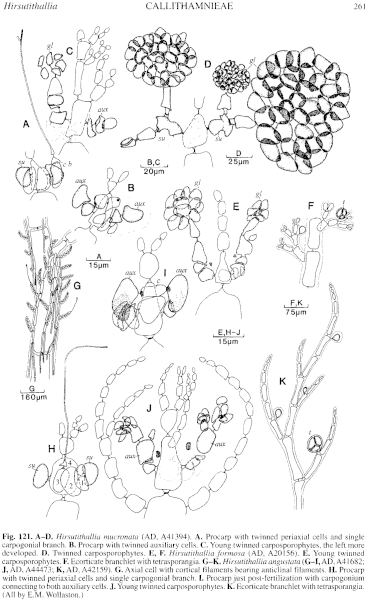|
|
|
|
|
|||||||||||
|
Electronic Flora of South Australia Species Fact Sheet
Phylum Rhodophyta – Order Ceramiales – Family Ceramiaceae – Tribe Callithamnieae
Synonyms
Callithamnion formosum Harvey 1863: pl. 281. J. Agardh 1876: 48. Sonder 1881: 10.
Spongoclonium formosum (Harvey) J. Agardh 1892: 41. Reinbold 1899: 50.
Lasiothalia formosa (Harvey) De Toni 1903: 1421. Lucas 1909: 52; 1929b: 52. Shepherd & Womersley 1981: 366. Womersley 1950: 179.
Thallus (Fig. 123A) erect, medium red-brown, (5–) 10–20 cm high, much branched with numerous laterals bearing alternately shorter subdistichous branches with ultimate ecorticate branchlets. Holdfast small, 0.5–1 mm across, rhizoidal; epiphytic on Amphibolis and probably epilithic. Structure. Ecorticate determinate branchlets (Fig. 123B) 1000–1500 (–2000) µm and many cells long, bearing shorter lateral branches alternately and more or less subdistichous, basal cells 60–95 µm in diameter and L/D about 1, tapering gradually to rounded terminal cells 6–10 µm in diameter and L/D 1.5–2, often bearing hairs; ultimate branchlets 4–8 cells and 90–180 µm long, alternately branched, basal cells 25–45 µm in diameter and L/D 1–1.5, decreasing to 6–10 µm in terminal cells. Axial cells of corticated branches (Fig. 123B) increasing to 500–700 µm in diameter and L/D 1–1.4, becoming densely corticated by descending rhizoidal filaments from the basal cells of lateral branchlets and bearing outer anticlinal filaments 3–6 (–10) cells and 100–180 µm long, at first sparse and separated, below dense. Cells uninucleate; rhodoplasts discoid to elongate, ribbon like or reticulate in older cells.
Reproduction: Gametophytes dioecious. Procarps situated 2–4 cells below the apex of ecorticate branchlets, with two opposite periaxial cells, one (the supporting cell) bearing a 4-celled carpogonial branch, the carpogonium dividing post-fertilization and each cell uniting via a connecting cell with an auxiliary cell cut off each periaxial cell (Fig. 123C), which then each produce a primary gonimoblast cell (Fig. 121E) and rounded lobes of ovoid carposporangia 20–30 µm in diameter; involucral filaments (Fig. 123D) develop from cells below the procarp and curve up and around the carposporophytes. Spermatangial clusters on cells of lesser ecorticate branchlets, branched 2–3 times.
Tetrasporangia (Figs 121F, 123E) are borne singly on cells of the ecorticate branchlets, sessile, subspherical, 30–50 µm in diameter.
Type from Port Phillip Heads, Vic., (Harvey); lectotype in Herb. Harvey, TCD (Alg. Aust. Exsicc. 515).
Selected specimens: Venus Bay, S. Aust., drift (Womersley, 12.0.1954; AD, A19490). Investigator Strait, S. Aust., 23 m deep (Watson, 28.i.1971; AD, A41020). Marino, S. Aust., drift on Amphibolis antarctica (Womersley, 22.ix.1945; AD, A1979). Vivonne Bay, Kangaroo I., S. Aust., drift (Womersley, 14.i.1948; AD, A6879). Point Reynolds, Kangaroo I., S. Aust., epiphytic, drift (Womersley, 28.x.1995; AD, A64586). Pennington Bay, Kangaroo I., S. Aust., drift (Wollaston, 11.0.1956; AD, A20156). Bridport, Tas. (Lucas & Perrin, Sept. 1930; AD, A49670).
Distribution: Venus Bay, S. Aust., to Port Phillip Heads, Vic., and the north coast of Tasmania.
Taxonomic notes: H. formosa is a relatively robust and openly branched species, distinguished (along with H. angustata) by the involucre of filaments around the carposporophytes. The cells are shorter and broader than in H. angustata, with markedly shorter ultimate branches on the ecorticate branchlets.
References:
AGARDH, J.G. (1876). Species Genera et Ordines Algarum. Vol. 3, Part 1- Epicrisis systematic Floridearum, pp. i-vii, 1–724. (Weigel: Leipzig.)
AGARDH, J.G. (1892). Analecta Algologica. Acta Univ. lund. 28, 1–182, Plates 1–3.
DE TONI, G.B. (1903). Sylloge Algarum omnium hucusque Cognitarum. Vol. 4. Florideae. Sect. 3, pp. 775–1521 + 1523–1525. (Padua.)
HARVEY, W.H. (1863). Phycologia Australica. Vol. 5, Plates 241–300, synop., pp. i-lxxiii. (Reeve: London.)
LUCAS, A.H.S. (1909). Revised list of the Fucoideae and Florideae of Australia. Proc. Linn. Soc. N.S.W. 34, 9–60.
LUCAS, A.H.S. (1929b). A census of the marine algae of South Australia. Trans. R. Soc. S. Aust. 53, 45–53.
REINBOLD, T. (1899). Meeresalgen von Investigator Street (Slid Australien), gesammelt von Miss Nellie Davey (Waltham, Honiton). Hedwigia 38, 39–51.
SHEPHERD, S.A. & WOMERSLEY, H.B.S. (1981). The algal and seagrass ecology of Waterloo Bay, South Australia. Aquat. Bot. 11, 305–371.
SONDER, O.W. (1881). In Mueller, F., Fragmenta Phytographiae Australiae. Supplementum ad volumen undecinum: Algae Australianae hactenus cognitae, pp. 1–42, 105–107. (Melbourne.)
WOMERSLEY, H.B.S. (1950). The marine algae of Kangaroo Island. III. List of Species 1. Trans. R. Soc. S. Aust. 73, 137–197.
The Marine Benthic Flora of Southern Australia Part IIIC complete list of references.
Publication:
Womersley, H.B.S. (24 December, 1998)
The Marine Benthic Flora of Southern Australia
Rhodophyta. Part IIIC. Ceramiales – Ceramiaceae, Dasyaceae
©State Herbarium of South Australia, Government of South Australia
Illustrations in Womersley Part IIIA, 1998: FIGS 121E, F, 123.

Figure 121 enlarge
Fig. 121. A–D. Hirsutithallia mucronata (AD, A41394). A. Procarp with twinned periaxial cells and single carpogonial branch. B. Procarp with twinned auxiliary cells. C. Young twinned carposporophytes, the left more developed. D. Twinned carposporophytes. E, F. Hirsutithallia formosa (AD, A20156). E. Young twinned carposporophytes. F. Ecorticate branchlet with tetrasporangia. G–K. Hirsutithallia angustata (G–I, AD, A41682; J, AD, A44473; K, AD, A42159). G. Axial cell with cortical filaments bearing anticlinal filaments. H. Procarp with twinned periaxial cells and single carpogonial branch. I. Procarp just post-fertilization with carpogonium connecting to both auxiliary cells. J. Young twinned carposporophytes. K. Ecorticate branchlet with tetrasporangia. (All by E.M. Wollaston.)

Figure 123 enlarge
Fig. 123. Hirsutithallia formosa (A, C–E, AD, A20156; B, A64586). A. Habit. B. Corticated axis with ecorticate branchlets. C. Twinned young carposporophytes on axial cell. D. Branches with carposporophytes. E. Ecorticate branchlets with tetrasporangia.

|
Email Contact: State Herbarium of South Australia |

|